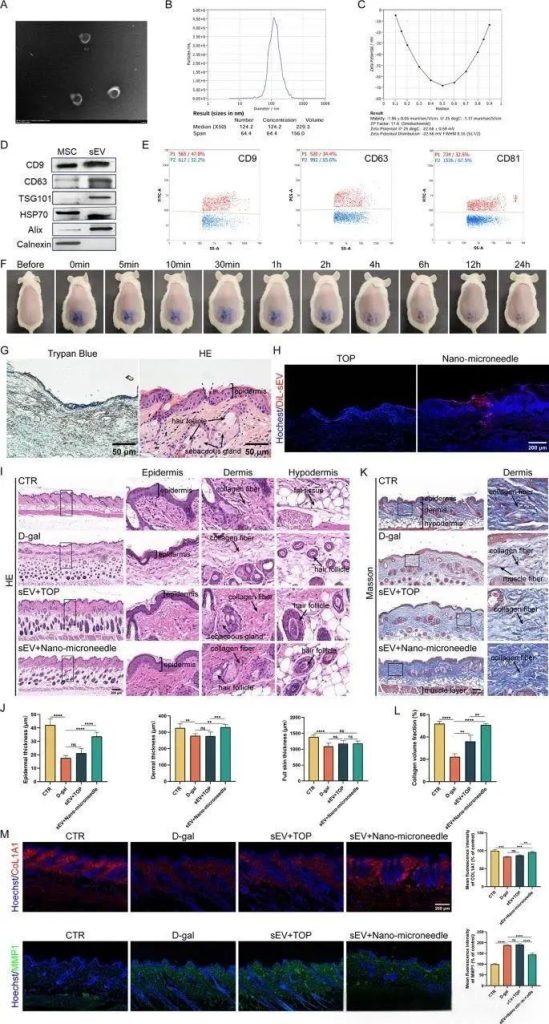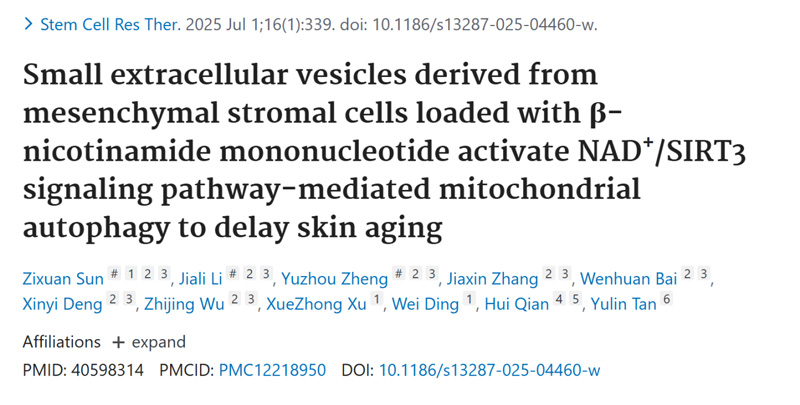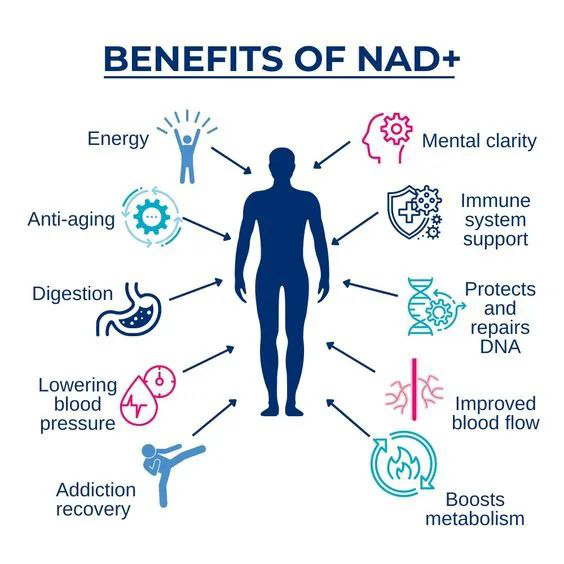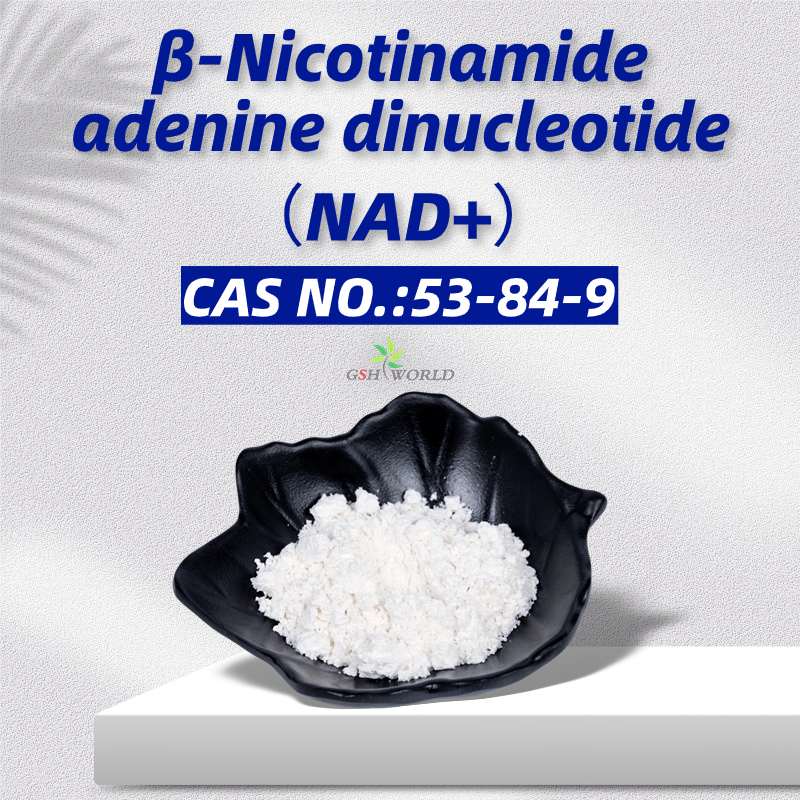New breakthrough in anti-aging: Exosomes carrying NMN revitalize the skin, reducing wrinkles by 82.6% and restoring collagen by 95.3%
Recently, the Research team of the Medical College of Jiangsu University published a significant achievement in the internationally renowned journal “Stem Cell Research & Therapy”, injecting new vitality into the field of anti-aging.
They have developed a new anti-aging strategy:
By using small extracellular vesicles (sEVs) derived from mesenchymal stromal cells as “carriers”, β-nicotinamide mononucleotide (NMN) was precisely “loaded” into them, achieving efficient delay of skin aging.
This innovation not only provides a brand-new theoretical support for skin anti-aging, but also demonstrates great potential in medical aesthetics and anti-aging applications.
“pain points” and innovative ideas in anti-aging Research
The skin, as the largest organ of the human body, is the most direct manifestation of aging.
As people age, their skin may experience problems such as deepening wrinkles, loss of collagen, and decreased elasticity, which are closely related to cellular aging and abnormal mitochondrial function.
Scientists have discovered that small extracellular vesicles (sEVs) secreted by human umbilical cord mesenchymal stromal cells (hucMSC) have the potential to repair damage and delay aging, but their natural effects are limited.
While NMN, as a classic anti-aging substance, can delay aging by increasing the level of NAD+ in the body, it is difficult to be widely applied due to its high water solubility, poor permeability and insufficient stability.
Extracellular vesicles (EVs) can be classified into small extracellular vesicles (sEVs, <200 nm) and large extracellular vesicles (lEVs, >200 nm) based on their particle size.
Exosomes are a typical type of sEVs, with specific sources and characteristics. For instance, the document mentions that hucMSC-sEVs express characteristic markers such as CD9, CD63, TSG101, HSP70, and Alix, and these markers are also common markers of exosomes.
Exosomes are a subset of sEVs, which contain various extracellular vesicles with a particle size of less than 200nm, including exosomes.
To combine the advantages of both, the research team innovatively adopted electroporation technology to “load” NMN into hucMSC-sEVs and construct NMN-SEVs.
This “upgraded” vesicle can not only leverage the targeted delivery capabilities of sEVs but also address the application limitations of NMN, making it a “golden combination” in the anti-aging field.
Comprehensive validation from cells to animals
To verify the effect of NMN-sEVs, the research team designed a series of experiments:
1. Establish an aging model
By applying D-galactose (a substance that can accelerate skin aging) to the skin of mice, a model similar to natural aging was constructed.
The skin of the mice would show typical aging characteristics such as deepened wrinkles, thinning of the epidermis, and reduction of collagen, providing an ideal research object for subsequent experiments.
2. Optimize administration method
After comparing the two administration methods of local application and nano-microneedles, it found that nano-microneedles can enable sEVs to penetrate the skin barrier more efficiently and reach the dermis, with a more significant anti-aging effect.
All subsequent experiments were conducted using nano-microneedles for drug administration.
3. Preparation and Detection of NMN-sEVs
By using electroporation technology, NMN successfully loaded into sEVs.
Through high-performance liquid chromatography detection, it found that when the sEVs concentration was 1×10¹⁰ particles/ml and the NMN concentration 30mM, the loading efficiency was the highest, reaching 44.13%.
Electron microscopic observation showed that NMN-sEVs maintained the complete structure of the vesicles and could function stably.
4. Verify effect from multiple dimensions
At the animal level: After administering NMN-sEVs to aging mice, skin wrinkles became shallower, epidermal thickness recovered, and collagen content increased, even approaching the state of normal mice.

This study, by innovatively constructing NMN-loaded human umbilical cord mesenchymal stem cell exosomes (NMN-sEVs) and combining them with nano-microneedles, confirmed that they can efficiently penetrate the skin barrier and significantly improve the D-galactose-induced skin aging phenotype: wrinkle depth reduced by 82.6%, and collagen density restored by 95.3%.
The core mechanism lies in activating the NAD⁺/SIRT3 signaling axis, which increases the intracellular NAD⁺ level by 3.2 times, thereby promoting LC3B-mediated mitochondrial autophagy by 3.8 times, eliminating damaged mitochondria and restoring cellular energy metabolism.
Cellular level: In skin fibroblasts cultured in vitro (key cells responsible for synthesizing collagen), NMN-sEVs can reduce the expression of markers of cellular aging, lower the level of oxidative stress, and promote cell proliferation;
Mechanism level: Through detection, it found that NMN-sEVs can increase the level of NAD + within cells, activate SIRT3 protein (a key molecule regulating mitochondrial function), and thereby promote mitochondrial autophagy – that is, to clear damaged mitochondria and restore mitochondrial function, thereby delaying cellular aging from the root.
core discovery is that NAD+/SIRT3 pathway is key
The most crucial breakthrough of the research lies in revealing the anti-aging mechanism of NMN-sEVs:
It does not simply “mask” aging, but rather initiates mitochondrial autophagy by activating the NAD+/SIRT3 signaling pathway.
Mitochondria known as the “cellular energy factory”. Abnormal function of mitochondria can lead to insufficient energy supply, increased oxidative stress, and accelerate cellular aging.
After entering cells, NMN-sEVs will increase the level of NAD + and activate SIRT3.
SIRT3 acts like a “quality inspector”, identifying and eliminating damaged mitochondria, allowing healthy mitochondria to “come to work”, thereby restoring cell vitality and reducing signs of skin aging.
To verify this mechanism, the research team used a SIRT3 inhibitor (3-TYP).
The results showed that after the addition of the inhibitor, the anti-aging effect of NMN-sEVs significantly weakened, further proving the core role of SIRT3 therein.
The value of this research goes far beyond a set of astonishing anti-aging data.
The most ingenious aspect of it lies in the perfect combination of the targeted delivery advantage of sEVs and the anti-aging effect of NMN.
It not only solves the problem of traditional anti-aging substances being “unable to enter and retain”, but also activates the “self-repairing ability” of aging skin at the cellular level.
Compared with simply applying external skin care products or supplementing a single ingredient, this “1+1 > 2” strategy is closer to the essence of skin aging and has a more long-term effect.




